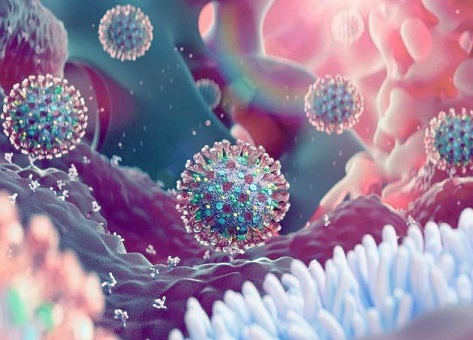Long-term dysregulation of the gut in response to SARS-CoV-2 viral persistence contributes to Long COVID
Nikhil Prasad Fact checked by:Thailand Medical News Team Aug 09, 2024 1 year, 4 months, 3 days, 9 hours, 55 minutes ago
COVID-19 News: A recent study by researchers from McMillan Research Ltd-UK the University of Leeds-UK, and Michigan State University-USA has uncovered new insights into the mechanisms of Long COVID, emphasizing the critical role of the gut in the persistence of the virus. This
COVID-19 News explores the comprehensive findings of this study.
 Long-term dysregulation of the gut in response to SARS-CoV-2 viral persistence
Long-term dysregulation of the gut in response to SARS-CoV-2 viral persistence
contributes to Long COVID
Understanding Long COVID
Long COVID, also known as post-acute sequelae of COVID-19 (PASC), affects millions of people worldwide. It manifests through a wide range of symptoms that can last for months after the initial infection. These symptoms include fatigue, headaches, muscle pain, concentration difficulties, and sleep disturbances. While the exact cause of Long COVID remains elusive, researchers have proposed several mechanisms, including persistent viral fragments in the body.
The Role of ACE-2 in COVID-19
The SARS-CoV-2 virus, responsible for COVID-19, primarily uses the angiotensin-converting enzyme 2 (ACE-2) as its entry point into human cells. ACE-2 is a multifunctional protein found on the surfaces of cells in various organs, including the lungs, heart, kidneys, and intestines. Its role extends beyond viral entry, influencing cardiovascular and intestinal functions.
Viral Persistence and the Gut
A key finding of the study is the potential long-term persistence of SARS-CoV-2 in the gut. Researchers observed that viral RNA and proteins were present in intestinal biopsies of patients with Long COVID. Interestingly, these viral remnants were found in specific types of cells within the intestines, suggesting a targeted persistence rather than a generalized infection.
Cell Types Involved
The study identified several types of intestinal cells that might harbor the viral remnants:
-Enterochromaffin Cells (ECs): These neuroendocrine cells are responsible for producing serotonin, a key neurotransmitter. The study suggests that SARS-CoV-2 may persist in these cells, leading to dysregulation of gut functions and contributing to symptoms like fatigue and mood disturbances.
-Tuft Cells: Tuft cells are chemosensory cells that can sense the environment of the gut. They play a role in immune responses and may be involved in the persistence of SARS-CoV-2 due to their ability to evade immune detection.
-Cup Cells: These cells, which express vimentin, a co-receptor for SARS-CoV-2, may also be involved in the persistence of the virus. The presence of autoantibodies against G protein receptors, which are associated with cup cells, suggests a possible link to persistent viral fragments.
The Immune Response
The study highlights the role of the
immune system in Long COVID. CD8 T cells, which are crucial for immune responses, were found in the intestinal lining of patients. These cells may be reacting to persistent viral antigens, leading to chronic inflammation and contributing to Long COVID symptoms.
Autopsy Findings
Autopsy studies of Long COVID patients revealed widespread viral RNA in various tissues, including the intestines, up to 230 days after the initial infection. This persistence of viral RNA without active replication suggests that the immune system may struggle to completely clear the virus from certain tissues.
The Gut-Brain Axis
One of the intriguing aspects of Long COVID is the cognitive dysfunction, often referred to as "brain fog." The gut-brain axis, a bidirectional communication system between the gut and the brain, may play a significant role in this symptom. Gut dysbiosis, or microbial imbalance, has been linked to cognitive issues, and persistent viral fragments in the gut could exacerbate this connection.
Potential Implications
Understanding the role of the gut in Long COVID opens new avenues for treatment and management. Targeting the specific cells harboring viral remnants and modulating the immune response could help alleviate the symptoms of Long COVID. Additionally, addressing gut health through diet, probiotics, and other interventions might offer relief to affected individuals.
Conclusion
The findings from McMillan Research Ltd., the University of Leeds, and Michigan State University provide a deeper understanding of Long COVID and its connection to the gut. This study emphasizes the importance of considering the gastrointestinal system when addressing the lingering effects of COVID-19.
By focusing on the gut and its complex interactions with the immune system and other organs, researchers hope to develop more effective strategies for managing Long COVID and improving the quality of life for those affected.
The study findings were published in the peer-reviewed journal: Viruses.
https://www.mdpi.com/1999-4915/16/8/1266
For the
COVID-19 News, keep on logging to Thailand Medical News.
Read Also:
https://www.thailandmedical.news/news/covid-19-s-lingering-impact-t-cell-activation-and-viral-persistence-up-to-two-years
https://www.thailandmedical.news/news/scientists-warn-that-viral-persistence-is-the-primary-contributing-factor-to-long-covid
https://www.thailandmedical.news/news/study-shows-that-sars-cov-2-evolutionary-and-mutation-rate-is-not-enhanced-by-immunodeficiencies-but-rather-by-viral-persistence
